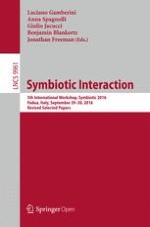1 Introduction
2 CA, Quantified-Self and HRI
3 Experiment’s Set up
3.1 Woz Set up
3.2 Activity’s Scenario: The Musical Quiz
3.3 Turn Design and Robot’s Profile
3.4 Data Collected
4 Interactional Symbiosis as a Moment-by-Moment Achievement
4.1 Working Out Social Synergy (1): Co-presence Management


4.2 Working Out Social Synergy (2): Epistemic Balance and Preference for Agreement


